Improved glucose homeostasis in mice with muscle-specific deletion of protein-tyrosine phosphatase 1B
- PMID: 17724080
- PMCID: PMC2169063
- DOI: 10.1128/MCB.00959-07
Improved glucose homeostasis in mice with muscle-specific deletion of protein-tyrosine phosphatase 1B
Abstract
Obesity and type 2 diabetes are characterized by insulin resistance. Mice lacking the protein-tyrosine phosphatase PTP1B in all tissues are hypersensitive to insulin but also have diminished fat stores. Because adiposity affects insulin sensitivity, the extent to which PTP1B directly regulates glucose homeostasis has been unclear. We report that mice lacking PTP1B only in muscle have body weight and adiposity comparable to those of controls on either chow or a high-fat diet (HFD). Muscle triglycerides and serum adipokines are also affected similarly by HFD in both groups. Nevertheless, muscle-specific PTP1B(-/-) mice exhibit increased muscle glucose uptake, improved systemic insulin sensitivity, and enhanced glucose tolerance. These findings correlate with and are most likely caused by increased phosphorylation of the insulin receptor and its downstream signaling components. Thus, muscle PTP1B plays a major role in regulating insulin action and glucose homeostasis, independent of adiposity. In addition, rosiglitazone treatment of HFD-fed control and muscle-specific PTP1B(-/-) mice revealed that rosiglitazone acts additively with PTP1B deletion. Therefore, combining PTP1B inhibition with thiazolidinediones should be more effective than either alone for treating insulin-resistant states.
Figures
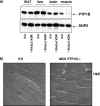
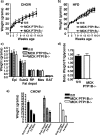
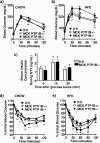

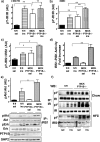

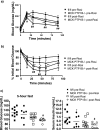
Similar articles
-
Liver-specific deletion of protein-tyrosine phosphatase 1B (PTP1B) improves metabolic syndrome and attenuates diet-induced endoplasmic reticulum stress.Diabetes. 2009 Mar;58(3):590-9. doi: 10.2337/db08-0913. Epub 2008 Dec 15. Diabetes. 2009. PMID: 19074988 Free PMC article.
-
Rosiglitazone ameliorates abnormal expression and activity of protein tyrosine phosphatase 1B in the skeletal muscle of fat-fed, streptozotocin-treated diabetic rats.Br J Pharmacol. 2005 Sep;146(2):234-43. doi: 10.1038/sj.bjp.0706306. Br J Pharmacol. 2005. PMID: 15997237 Free PMC article.
-
Effects of hepatic protein tyrosine phosphatase 1B and methionine restriction on hepatic and whole-body glucose and lipid metabolism in mice.Metabolism. 2015 Feb;64(2):305-14. doi: 10.1016/j.metabol.2014.10.038. Epub 2014 Nov 5. Metabolism. 2015. PMID: 25468142 Free PMC article.
-
PTP1B and TCPTP--nonredundant phosphatases in insulin signaling and glucose homeostasis.FEBS J. 2013 Jan;280(2):445-58. doi: 10.1111/j.1742-4658.2012.08563.x. Epub 2012 Apr 18. FEBS J. 2013. PMID: 22404968 Review.
-
Protein tyrosine phosphatase 1B (PTP1B) and obesity.Vitam Horm. 2013;91:405-24. doi: 10.1016/B978-0-12-407766-9.00017-1. Vitam Horm. 2013. PMID: 23374726 Review.
Cited by
-
Protein tyrosine phosphatase-1B modulates pancreatic β-cell mass.PLoS One. 2014 Feb 28;9(2):e90344. doi: 10.1371/journal.pone.0090344. eCollection 2014. PLoS One. 2014. PMID: 24587334 Free PMC article.
-
Protein tyrosine phosphatase 1B and insulin resistance: role of endoplasmic reticulum stress/reactive oxygen species/nuclear factor kappa B axis.PLoS One. 2013 Oct 18;8(10):e77228. doi: 10.1371/journal.pone.0077228. eCollection 2013. PLoS One. 2013. Retraction in: PLoS One. 2022 Aug 4;17(8):e0272823. doi: 10.1371/journal.pone.0272823. PMID: 24204775 Free PMC article. Retracted.
-
Differentiation-dependent PTPIP51 expression in human skeletal muscle cell culture.J Histochem Cytochem. 2009 May;57(5):425-35. doi: 10.1369/jhc.2008.952846. Epub 2009 Jan 5. J Histochem Cytochem. 2009. PMID: 19124842 Free PMC article.
-
Relationship status update for PTP1B and LepR: It׳s complicated.Mol Metab. 2014 Feb 7;3(3):217-8. doi: 10.1016/j.molmet.2014.01.015. eCollection 2014 Jun. Mol Metab. 2014. PMID: 24749051 Free PMC article. No abstract available.
-
Tyrosine phosphorylation of Kir6.2 subunit negatively regulates cardiac KATP channel activity.Basic Res Cardiol. 2025 Jun;120(3):473-488. doi: 10.1007/s00395-025-01108-x. Epub 2025 Apr 19. Basic Res Cardiol. 2025. PMID: 40251281 Free PMC article.
References
-
- Ahmad, F., and B. J. Goldstein. 1995. Increased abundance of specific skeletal muscle protein-tyrosine phosphatases in a genetic model of insulin-resistant obesity and diabetes mellitus. Metabolism 44: 1175-1184. - PubMed
-
- Bence, K. K., M. Delibegovic, B. Xue, C. Z. Gorgun, G. S. Hotamisligil, B. G. Neel, and B. B. Kahn. 2006. Neuronal PTP1B regulates body weight, adiposity and leptin action. Nat. Med. 12: 917-924. - PubMed
-
- Biddinger, S. B., and C. R. Kahn. 2006. From mice to men: insights into the insulin resistance syndromes. Annu. Rev. Physiol. 68: 123-158. - PubMed
-
- Bruning, J. C., M. D. Michael, J. N. Winnay, T. Hayashi, D. Horsch, D. Accili, L. J. Goodyear, and C. R. Kahn. 1998. A muscle-specific insulin receptor knockout exhibits features of the metabolic syndrome of NIDDM without altering glucose tolerance. Mol. Cell 2: 559-569. - PubMed
-
- Byon, J. C., K. A. Kenner, A. B. Kusari, and J. Kusari. 1997. Regulation of growth factor-induced signaling by protein-tyrosine-phosphatases. Proc. Soc. Exp. Biol. Med. 216: 1-20. - PubMed
Publication types
MeSH terms
Substances
Grants and funding
LinkOut - more resources
Full Text Sources
Other Literature Sources
Medical
Molecular Biology Databases
Miscellaneous
